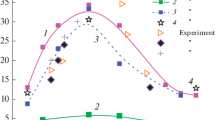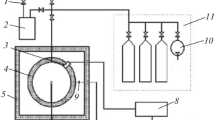Abstract
The structure of heat release and the dynamics of formation of radicals and methane oxidation in a wave of filtration combustion of gases in fuel-rich methane–air compositions is studied with the use of skeleton diagrams and sensitivity analysis. Depending on heat release, the wave is divided into a preheating zone, an exothermic zone characterized by partial oxidation of methane in the reaction CH4 + 0.5O2 = CO + 2H2, and an endothermic zone with the conversion processes CO + H2O = CO2 + H2 and CH4 + H2O = CO + 3H2. It is shown that the composition of products in the wave front is essentially nonequilibrium. Several typical regions are also identified from the viewpoint of prevailing reactions of formation of the basic radicals in the wave. Thus, the dominating mechanism of chain branching is the reaction CH3 + O2 = CH3O + O in the “low-temperature” region, H2O2(+M) = 2OH(+M) and HO2 + CH3 = CH3O + OH in the “transitional” region, and H + O2 = O + OH in the “high-temperature” region. Two former regions correspond to the preheating zone and the latter region corresponds to the exothermic peak of the wave of filtration combustion of gases.
Similar content being viewed by others
REFERENCES
V. S. Babkin, “Filtrational combustion of gases,” Pure Appl. Chem., 65, 335–344 (1993).
L. A. Kennedy, A. A. Fridman, and A. V. Saveliev, “Superadiabatic combustion in porous media: wave propagation, instabilities, new type of chemical reactor,” Int. J. Fluid Mech. Res., 2, 1–27 (1995).
M. K. Drayton, A. V. Saveliev, L. A. Kennedy, et al. “Superadiabatic partial oxidation of methane in reciprocal and counterow porous burners,” in: The 27th Symp. (Int.) on Combustion, The Combustion Inst., Pittsburgh (1998), pp. 1361–1367.
V. V. Gavrilyuk, Yu. M. Dmitrenko, S. A. Zhdanok, et al., “Investigation of methane conversion to hydrogen in the regime of a single filtration-combustion wave,” in: Proc. IV Int. Forum, Vol. 4, Minsk (2000), pp. 21–31.
P. F. Hsu and R. D. Matthews, “The necessity of using detailed kinetics in models for premixed combustion within porous media,” Combust. Flame, 93, 457–466 (1993).
J. R. Howell, M. J. Hall, and J. L. Ellzey, “Combustion of hydrocarbon fuels within porous inert media,” Prog. Ener. Combust. Sci., 22, 121–145 (1996).
L. A. Kennedy, J. P. Binque, M. K. Drayton, et al., “Chemical structures of filtration combustion waves in porous media,” in: Proc. 27th Int. Symp. on Combustion, Pittsburgh (1998), p. 403.
M. R. Henneke and J. L. Ellzey, “Modeling offiltration combustion waves in porous media,” Combust. Flame, 117, 832–840 (1999).
L. A. Kennedy, J. P. Binque, A. V. Saveliev, et al., “Chemical structures of methane-airfiltration combustion waves for fuel-lean and fuel-rich conditions,” in: Proc. 28th Int. Symp. on Combustion, Pittsburgh (2000), p. 26.
G. P. Smith, D. M. Golden, M. Frenklach, et al., “GRI-Mech 3.0,” in: http://www.me.berkeley.edu /gri_mech/.
R. J. Kee, J. F. Grcar, M. D. Smooke, and J. A. Miller, “A Fortran chemical kinetics package for the analysis of gas-phase chemical kinetics,” Sandia Report No. SAND85-8240 UC-401 (1985).
Yu. M. Laevskii and V. S. Babkin, “Filtration combustion of gases,” in: Propagation of Heat Waves in Heterogeneous Media [in Russian], Nauka, Novosibirsk (1988), pp. 118–120.
S. I. Futko, “Effect of kinetic properties of a mixture on wave macrocharacteristics of filtration combustion of gases,” Combust. Expl. Shock Waves, 39, No. 1, 11–22 (2003).
A. I. Rozlovskii, Fundamentals of Explosion Safety in Working with Combustible Gases and Vapors [in Russian], Khimiya, Moscow (1980), p. 207.
S. I. Futko, “Kinetic analysis of the chemical structure of filtration-combustion waves in fuel-lean mixtures,” Combust. Expl. Shock Waves, 39, No. 3, 261–269 (2003).
J. Warnatz, “Resolution of gas phase and surface combustion chemistry into elementary reactions,” in: 24th (Int.) Symp. on Combustion, Pittsburgh (1992), pp. 553579.
S. I. Futko, A. V. Saveliev, L. A. Kennedy, and S. A. Zhdanok, “Reaction path analysis of the structure of rich methane-airfiltrational combustion wave,” in: Modern Problems of Combustion and Its Applications, Proc. 3rd Int. School-Seminar, Minsk (1999), pp. 31–35.
A. L. Dicks, “Hydrogen generation from natural gas for the fuel cell systems of tomorrow,” J. Power Sources, 61, 113124 (1996).
N. Peters and F. A. Williams, “The asymptotic structure of stoichiometric methane</del>-air flames,”Combust. Flame, 68, 185207 (1987).
K. Seshadri, X. S. Bai, H. Pitsch, and N. Peters, “Asymptotic analysis of the structure of moderately rich methane-air flames,” Combust. Flame, 113, 589602 (1998).
Author information
Authors and Affiliations
Rights and permissions
About this article
Cite this article
Futko, S.I. Kinetic Analysis of the Chemical Structure of Waves of Filtration Combustion of Gases in Fuel-Rich Compositions. Combustion, Explosion, and Shock Waves 39, 437–447 (2003). https://doi.org/10.1023/A:1024786805591
Issue Date:
DOI: https://doi.org/10.1023/A:1024786805591




